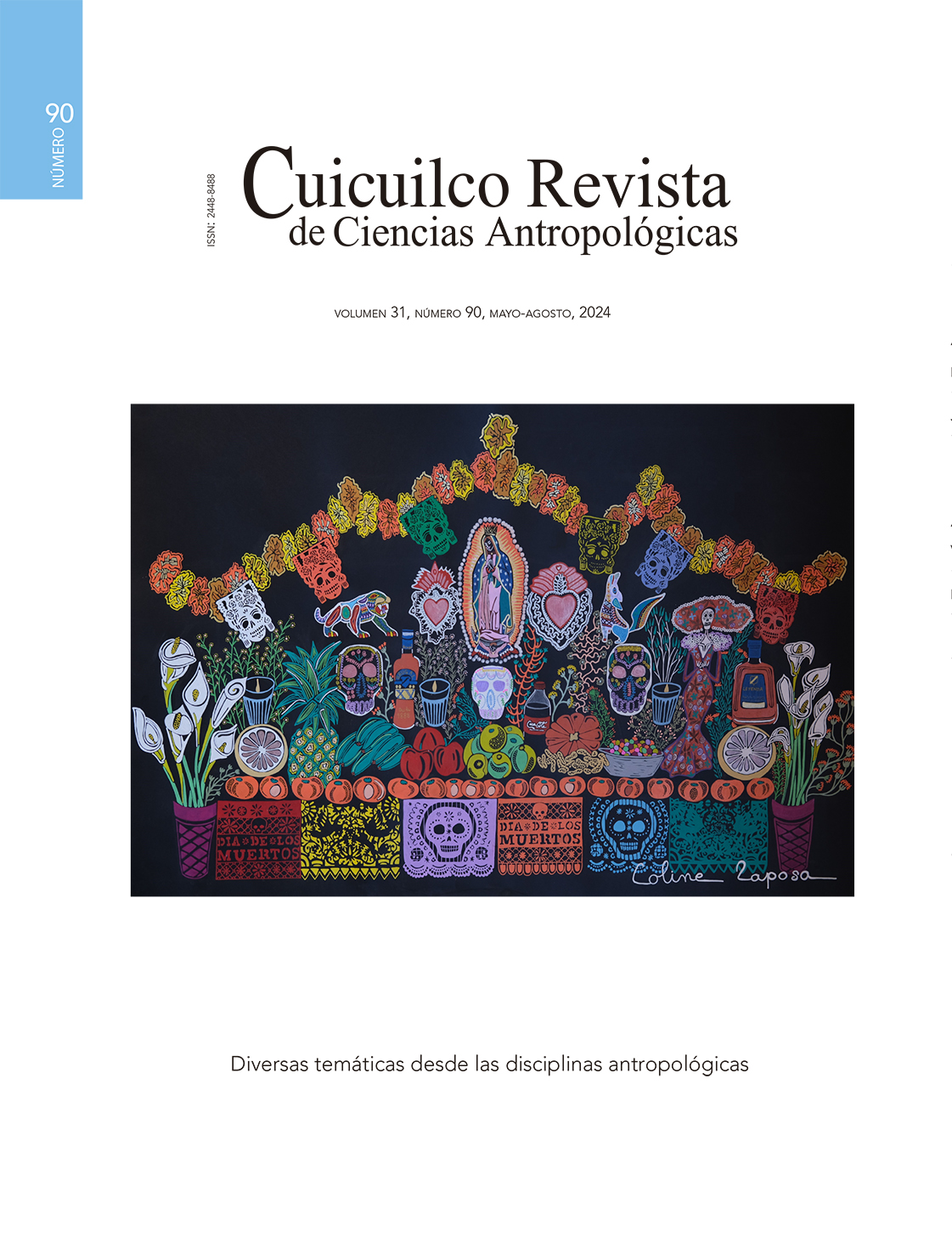The look of a serial killer
Keywords:
mataviejitas, CaraMex, mestizaje, serial killers, criminality, little old lady serial killer.Abstract
In this article, I analyze the sketches used by police, media, Criminologists, Scientists and Official Authorities for the arrest of El/La Mataviejitas. Just as important as analyzing the details of the sketches is understanding the software called La Cara del Mexicano, used to produce them, since their technological basis contributed to the perception that they were accurate and informative, based on the various “types” that representatively constitute the Mexican faces, determined “objectively” by physical anthropologists and forensic specialists. The analysis of these reveals how the national imaginaries of masculinity and femininity, and their relationship with the perception of class and skin color, have been reinforced through discourses of criminal representation since the 19th century. The portraits that the police and criminologists used to identify El/ La Mataviejitas, as well as the texts that accompanied them tell the story of national imaginaries about who constitutes a criminal.
Downloads
References
Baranda, Antonio y Ricardo Zamora
Alista PGJDF retrato de otro mataviejitas. Reforma, 24 de agosto.
Barrón Cruz, Martín Gabriel
El nudo del silencio: tras la pista de una asesina en serie, La Mataviejitas. Editorial Océano de México. México.
Brito, Luis y Juan Corona
Atrapan a Mataviejitas, lleva lista de ancianas.” Reforma, 26 de enero.
Birch, Helen
Introduction, en Moving Targets: Women, Murder and Representation, Helen Birch (ed.). University of California Press. Berkeley: 1-6.
Bolaños, Claudia
Buscan “Mataviejitas” entre-sexoservidores. El Universal, 18 de octubre.
a Las maté por rencor y odio. El Universal, 27 de enero, sec. DF. Comunidad y Metrópoli.
b Muestra “Mataviejitas” indiferencia por víctimas. El Universal, 3 de agosto, sec. Ciudad. <http://www.eluniversal.com.mx/ciudad/78369.html>. Consultado el 24 de febrero 2019.
Confirman sentencia de 759 años a La Mataviejitas. El Universal, 31 de marzo, Metrópoli. <http://www.eluniversal.com.mx/notas/494227.html>. Consultado 24 de febrero del 2019.
Bolaños, Claudia, Óscar Herrera y Ángeles Velazco
Las maté por rencor y rabia. Reforma, 26 de enero.
Buffington, Robert M.
Criminal and citizen in modern Mexico. University of Nebraska Press. Lincoln.
Cabral, Mauro y Paula Viturro
(Trans)Sexual Citizenship in Contemporary Argentina, en Transgender Rights, Paisley Currah, Richard M. Juang y and Shannon Minter (eds.). University of Minnesota Press. Minneapolis: 262-73.
Campbell, Anne
Men, women, and aggression. Basic Books. Nueva York.
De la Cadena, Marisol.
¿Son los mestizos híbridos? las políticas conceptuales de las identidades andinas. Universitas Humanística, (61): 51-84.
Díaz, César y Arturo Sierra
Paga Mataviejitas Protección a Judiciales. Reforma, febrero, sec. Justicia.
Dirección de Comunicación Institucional
“La Mataviejitas: ‘una sociópata’, asegura académica de la UIA”, comunicado de prensa, 26 de enero.
Donald, Christie, Davies Graham, John Shepherd y Ellis Haydyn
Evaluating a new computer-based system for face recall. Law and human behavior, 5 (2-3): 209-218.
Duggan, Lisa
Sapphic slasher: sex, violence, and American Modernity. Duke University Press. Durham y Londres.
Edwards, Susan
Women on Trial. Manchester University Press. Manchester.
Fernández, Leticia
Es ‘Mataviejitas’ brillante: Bátiz. Reforma, 11 de octubre.
French, William E.
Prostitutes and guardian angels: women, work, and the family in Porfirian Mexico. The Hispanic American Historical Review, 72 (4): 529-53.
Jones, Ann
Women Who Kill. 2da edición. New York: Feminist Press.
Grindstaff, Laura, y McCaughey Martha.
Re-Membering John Bobbitt: Castration Anxiety, Male Hysteria, and the Phallus. En No Angels : Women Who Commit Violence, Alice Myers y Sarah Wight (eds.), Pandora, an imprint of Harper Collins Publishers, Londres; San Francisco: 142–60.
Green, David
Veins of resemblance: photography and eugenics. Oxford Art Journal, 7 (2): 3-16.
Gilbert, Paula Ruth
Discourses of Female Violence and Societal Gender Stereotypes. Violence against Women, 8 (11), 11 de noviembre: 1271-1300.
Hare, Robert
This Charming Psychopath, Psychology Today, 1 de enero.
Without Conscience: The Disturbing World of the Psychopaths among Us. Guilford Press. Nueva York.
Hasel, Lisa y Gary Wells
Catching the Bad Guy: Morphing Composite Faces Helps. Law and Human Behavior, 31 (2): 193-207.
Herrera, Óscar
Importan curso sobre homicidios seriales. El Universal, 10 de enero.
Jiménez, Carlos
a Atrapan a La Mataviejitas: Es mujer y es luchadora. La Crónica, enero, sec. Ciudad.
b Mataviejitas fue a pgjdf a entregarse y no la atendieron. Crónica, febrero, sec. Ciudad.
Jiménez, Carlos y R. Sánchez
Detiene PGJDF a 49, pero ninguno es El Mataviejitas. La Crónica, 5 de enero.
Moreno Figueroa, Mónica
Distributed Intensities: Whiteness, mestizaje and the Logics of Mexican Racism. Ethnicities, 10 (3): 387-401.
Martínez Baca, Francisco y Manuel Vergara
Estudios de Antropología Criminal. Benjamín Lara. Puebla, México.
Nila, Miguel
Ningún travestí resulto ser el Mataviejitas: Bátiz. Noticieros Televisa. 24 de octubre.
Ostrosky, Feggy
Mentes asesinas: la violencia en tu cerebro. Hachette Filipacchi Expansión de R.L. de C.V. México:
Picart, Caroline
Crime and the Gothic: sexualizing serial killers. Journal of Criminal Justice and Popular Culture 13 (1): 1-18.
Phillips, Sandra
Identifying the Criminal, en Police Pictures: The Photograph as Evidence. San Francisco Museum of Modern Art and Chronicle Books. San Francisco: 11-31.
Procuraduría General de Justicia del Distrito Federal (PGJDF)
El sistema de retrato hablado más avanzado del país en la PGJDF. Comunicado de prensa, 20 de junio. PGJDF. México.
Raine, Adrian y José Sanmartín
Violence and Psychopathy. Kluwer Academic, Plenum. Centro Reina Sofía. Nueva York.
Reisinger, Deborah S.
Murder and Banality in the Contemporary Fait Divers. South Central Review, 17 (4): 84-99.
Robichaux, David
Identidades indefinidas: entre “indio” y “mestizo”en México y América Latina. Amérique Latine Histoire et Mémoire. Les Cahiers ALHIM. <http://journals.openedition.org/alhim/1753>. Consultado el 5 agosto 2024.
Rougmanac, Carlos
Los criminales en Mexico: ensayo de psicologia criminal. Por los Mundos del delito. Editor, Tipografia “El Fenix”.
Rushton, Richard
What Can a Face Do? On Deleuze and Faces. Cultural Critique, (51): 219-37.
Salgado, Agustín y Mirna Servín
A Juana Barraza Zamperio le gusta el rojo y prefería los martes y miércoles para matar. La Jornada, 26 de enero.
Salgado, Agustín y Mirna Servín
Cae mataviejitas tras consumar otro de sus crímenes; es mujer. La Jornada. 26 de enero.
Sekula, Allan
The Body and the Archive. October 39: 3-64.
Seltzer, Mark
Serial Killers: death and life in America’s wound culture. Routledge. Nueva York.
Serrano Sánchez, Carlos
Un sistema automatizado de identificación de rasgos faciales (retrato hablado) para la población mexicana, en La bibliotecología y la documentación en el contexto de la internacionalización y el acceso abierto. unam. México: 1-12.
Serrano Sánchez, Carlos, María Villanueva Sagrado, Jesús Luy y Karl Link F.
Los rasgos faciales del mexicano y los retratos hablados por computadora. Revista Universidad de México (575): 61-63.
Servín, Mirna
Asesiné por las ‘malas compañías’: La Mataviejitas. La Jornada, 27 de enero.
Sierra, Arturo
Analizan a seriales de Europa. Reforma, 24 de octubre.
a Intenta pgjdf encuadrar perfil de asesina serial. Reforma, 16 de febrero.
b Rompe con esquemas caso de ‘Mataviejitas. Reforma, 4 de febrero.
c Usan estilo francés con asesinos seriales. Reforma, 10 de enero.
Sierra, Arturo y Antonio Baranda
Toman huellas de 46. Reforma, 5 de octubre.
Sierra, Arturo y Leticia Fernández
Tienen 64 rostros del “Mataviejitas”. Reforma, 29 de noviembre.
Sierra, Arturo, Luis Ocampo, Luis Brito, Leticia Fernández et al.
Asesina Juana Por Coraje. Reforma, 26 de enero.
Sierra, Arturo, Ricardo Zamora y Antonio Baranda
Abusan en infancia de asesino en serie. Reforma, 31 de agosto.
Skrapec, Candice
The Female Serial Killer, en-Moving targets: women, murder and representation, Helen Birch (ed.). University of California Press. Berkely: 241-68.







